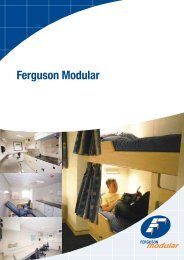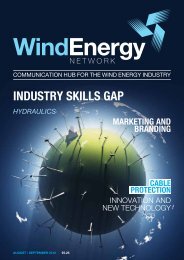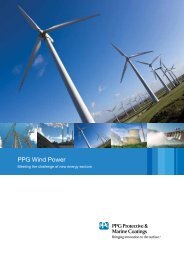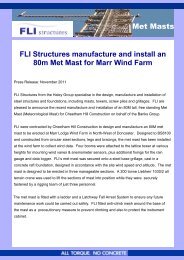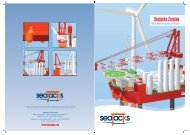JUNE/JULY 2013 | £5.25 - Wind Energy Network
JUNE/JULY 2013 | £5.25 - Wind Energy Network
JUNE/JULY 2013 | £5.25 - Wind Energy Network
Create successful ePaper yourself
Turn your PDF publications into a flip-book with our unique Google optimized e-Paper software.
BUSINESS DEVELOPMENTBUSINESS DEVELOPMENTChangingtheFuturePart 2PainlessPresentationsat WorkIn Part 1- PerformanceConsultant and ConferenceSpeaker Frank Newberryexplored how we canchange the future oneperson at a time bycoaching and mentoringindividualsIn Part 2 Frank looks athow we can leave a positivelegacy by giving painlesspresentations at work e.g.at meetings of all types andeven conferencesIt may seem a strange statement- ‘changing the future’ by givinga presentation or speaking at aconference, but bear with me. Myclaim is based on the testimony ofpeople who have made statementslike ‘that presentation changed mycareer’ and ‘that talk took me to ahigher level’.Use your fears to inform yourapproachI am not talking here about professionalspeakers – I am referring to audiencemember responses to ordinary staffmembers who have had the courage toget up and speak up, and in doing sohave gone on to inspire their colleagues.So yes - I assert that you are changing thefuture - one audience member at a time.A good place for you to start whencontemplating doing what is effectivelypublic speaking might be - the fear andtrepidation that can grip us at the verythought of standing up to give a talk. Infact it might be interesting to use yourfears to inform your approach to givingpresentations in the workplace.I have been training conference speakersfor many years and not one has everclaimed that they got to their feet to speakwithout some anxiety. Some, including mestart getting nervous often days or weeksin advance!But like so many other things the moreyou do it the less you will suffer. Yourfears and anxieties may also go throughan interesting transition as you gatherexperience.Most speakers start out worrying aboutthemselves (Will I dry up? Do I lookOK?); they then transition or progressto worrying about their material (Is mycontent OK? Are my visual aids goingto work?). And finally they progress toworrying about their audience (Will I givethem what they need?).Prepare YourselfThis progression: Self – Material –Audience is not an illogical one and it canhelp you to prepare yourself and your talks… if you tackle them in reverse order. Firstfind out who will be in the audience andwhat their expectations of you are. Oncethis is known you can gather the data youneed to construct your presentation andthen finally you can make sure you lookgood and feel OK on the day.Most people in your audience want,perhaps most of all, to avoid sittingthrough a presentation where the speakergets embarrassed and messes up. Theywill have some concern and sympathyfor you as a new speaker but they wouldprefer to avoid witnessing your failure andhaving to pretend to you afterwards that itwas fine when it was not.It is vital then to spare your audience anyanxiety. You can do this by preparingwell and avoiding unnecessary risks. Forexample you might have a great joke youwant to tell. You figure that a good jokecan be a great start to a talk. It is howevera high return but a high risk option. If youabsolutely have to make a joke then makeone that is against yourself so that youraudience thinks you are mature enough tolaugh at yourself sometimes.A Simple StructureUse a simple structure to put across asimple message and confine yourself tojust three points. End with a ‘call to action’and keep the whole thing to 20 minutesor less. If 30 minutes or more is expectedof you then build in some participation ora question and answer session. There isa famous old quotation in praise of thebrevity of presentations. It goes somethinglike: ‘Stand up to be seen, speak up to beheard and sit down to be appreciated’.People will feel confident in you as apresenter if you use a simple structureand they will appreciate this even more ifyou make reference to it – for example. ‘Iwould like to begin by saying ...’; I wouldlike to move onto my first point now ...’and ‘In conclusion let me summarise ...’This technique (known as signposting) isthe most under-used one in presentationsand yet it makes the speaker sound logicaland professional. I recommend it.IntroductionYour introduction should indicate yourcontent, your objective and when in thetalk you intend to deal with questions fromthe audience. It helps if you can beginwith something topical and relevant to getpeople interested at the outset.Main PartAs mentioned above your presentationshould not have more than three points.You might have just one message butyou should seek to establish and reinforceyour message with no more than threepoints or examples. There is research thatsuggests that quoting three examplesis very persuasive. Any less than threeseems unconvincing and any more thanthree could well be seen as unnecessaryor a dilution of your key message(s).QuestionsIn my experience the best place forquestions is just before your conclusione.g. ‘Before I conclude are there anyquestions?’ This prevents any overenthusiasticquestioners from hi-jackingyour presentation at the end with irrelevantquestions and distracting comments. Letthem get it off their chest and then youcan summarise and conclude your talk.This way you will stand a much betterchance of restoring the audience’s focuson your key message(s).ConclusionHaving dealt with questions you cannow make your concluding remarksand summarise your main points foremphasis. The conclusion ought not tocontain any new material or surprises. Asimple and polite ‘call to action’ can alsobe very effective at the end, e.g. ‘I hopethat we will now be able now to make aninformed decision on this matter. Thankyou for your time’.Frank Newberrywww.franknewberry.com24 www.windenergynetwork.co.ukwww.windenergynetwork.co.uk 25



